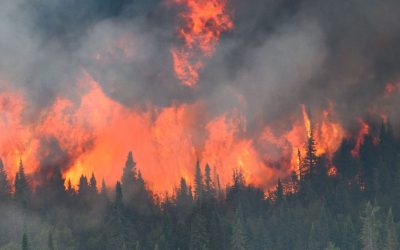
GRAPHICAL ANALYSIS FROM THE FRONTIER CENTRE FOR PUBLIC POLICY
Climate closely correlates with solar activity accounting for 80% of the trend over a 150-year period unlike C02. April 2020 over the Canadian prairies was the third coldest since 1985 averaging 3°C below normal.7 Since 1985 there also evidence that the Canadian Prairies has been losing 4 growing degrees’ days (GDDs) per year in the summer months related to diminishing solar activity.8 So why are we on the Canadian prairies paying a carbon tax while it cools?

- The current period of low solar activity (sunspot cycles 24/25), depicted in Figure 1, have been named the Eddy Solar Minimum.1
- In the years 2018, 2019 and 2020 at the end of cycle 24 there has been an average of 11.6, 4.8 and 1.7 sunspots/month versus the average of 55.8 for the period 1985-2018 (September-August).4
- The period 1814-1823 during Dalton minimum period (above chart) brought severe economic depression to northern Europe associated with extreme cold.2 Many scientists are concerned about cycle 25 in the Eddy solar minimum.5
- This last winter (2019/20) a massive blizzard in Newfoundland saw 75 cm of snow over a large area of Newfoundland with the city of St John’s ‘cut-off’ from the rest of Canada for over 36 hours with farmers also severely hampered (photo).4
- In 2007 UN’s IPPC categorically stated ‘winters in future would be milder and snow may disappear from land areas of the earth in a few decades.4 What’s happened?
- Since 2007 the Northern Hemisphere has witnessed three severe winters (e.g. 2009/10, 2011/12 and 2013/14) with the brunt of severity in Western Europe.4
- The winter of 2012/13 was extremely cold and snowy in parts of France, Germany, Belgium and Poland, with the city of Berlin experiencing its coldest winter in 100 years.4
- Mid-January 2020, an extreme cold spell over North America saw wind-chill values of -50 C and lower in western Canada some mid-western US States.4
- Easter weekend, April 11-13, 2020, saw 100s of cold & snowfall records broken in the U.S. Midwest; hardest hit states were: Montana, South Dakota, Colorado and Iowa.6
- Media and environmentalists continue to link recent extreme weather (EW) events to warming of the earth’s climate as a result of human-CO2 emissions.4
- April 29-30 Halifax was expected to receive 25 cm of snow after substantial amounts in New Brunswick.
- North American media typically ignores cold extreme news events while high-lighting warm extremes.
PDF VERSION FC089 Cooling May 2020
[show_more more=”Endnotes” less=”Close Endnotes”]
Endnotes:
- Archibald, D. 2014. Twilight of Abundance: Why Life in the 21st century will be Nasty, Brutish and Short. Regency Publishing, Washington D.C. 208 pp
- Browning, I. and Garissa, E.M. 1981. Past and Future History: A Planners Guide Fraser Publishing Company, Burlington, Vermont. 382 pp
- FC088Ray Garnett TEN OBSERVATIONS AT ODDS WITH
- Khandekar, M & R. Garnett.2020. Eart & Envi Scie Res &Rev www.opastonline.com Vol.3, Issue 2, 65-66.
- Whitehouse, David The Next Solar Cycle and Why it Matters for Climate, Note 2, The Global Warming Policy Foundation
- Electroverse
- Ray Garnett Climate and crop Letter May 8, 2020
- Garnett,E.R & M.L. Khandekar 2020 Is Diminishing Solar activity posing a threat the Canadian Prairie Agriculture. (Manuscript in preparation)
[/show_more]



